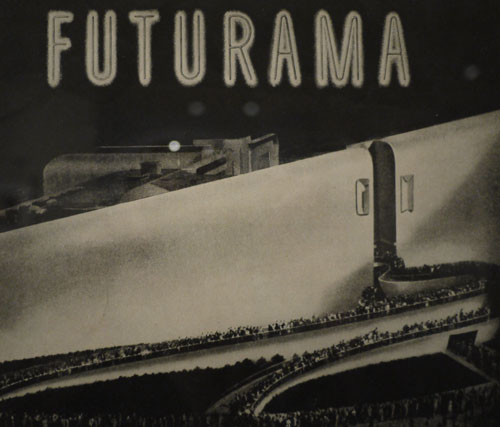
Image Credit: Laura Thain
Archives are by definition past-oriented. The very act of “archiving” renders an object an artifact of a specific past, although its orientation within that past depends on the disciplinary practice of the archivist. 20th century archival studies have made considerable movements toward standardization, and alongside this standardization of archival methodologies comes an expansion of that which we consider worthy of being archived. Thus, we no longer operate under the assumption that 20th century archives will be composed exclusively of objects from a distant, exclusively white Western patriarchal past—we compose queer archives, postcolonial archives, feminist archives, and, perhaps, in the case of Bel Geddes, even archives of the future. Join me as I explore the idea of a future archive and its relationship to the archival ethos of the Harry Ransom Center, in part by exploring exhibition visitor’s own “visions” of the future.
The push for expansion of Western archives in the 20th century operates at least in part on a simple premise: that those who write the past control the present. As the old saying goes, “history is written by the victors.” This implies a causal relationship in which the privilege of history writing is the purview of the dominant cultural force, but we must realize that power transfers both ways here—the very act of writing history can transform an underrepresented body into a powerful voice in the public sphere. So if the composition of the archive determines the perspective of the present, where can we place the future in such a schema? What place do imaginations of the future have in this archive? And how much can these imaginations serve as self-fulfilling prophecies, transforming futuristic visions into powerful agents of change?
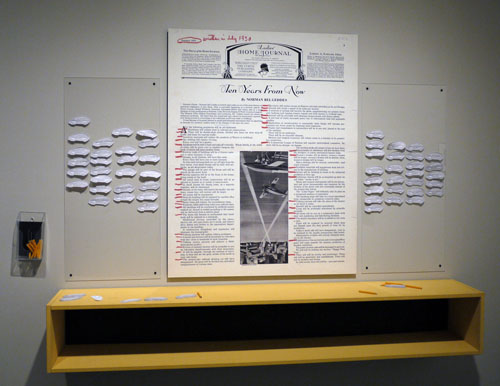
Image Credit: Laura Thain. Click for larger image.
The court of public opinion can help us here to determine how the idea of “the future” figures into public imagination. The Center ends the Bel Geddes exhibition with a display of Bel Geddes’ 1930 predictions of 1940. On either side of the display, there is space for viewers to make their own predictions about “the near future.”
The submissions generally break down into three categories: optimistic/utopic, pessimistic/apocalyptic, and neutral/technological. The optimistic responses reveal what viewers wish for in the future, often against the historical trajectories of the present: “nobama,” “astros win world series,” “less die,” “ Hispanic gay president,” “blending of races,” “no war or hunger,” “North/South Korean peace,” or “more pie.” As one submitted emphasizes, “HOPE! The future is now!” These optimistic views of the future make claims about what viewers desire in the present.
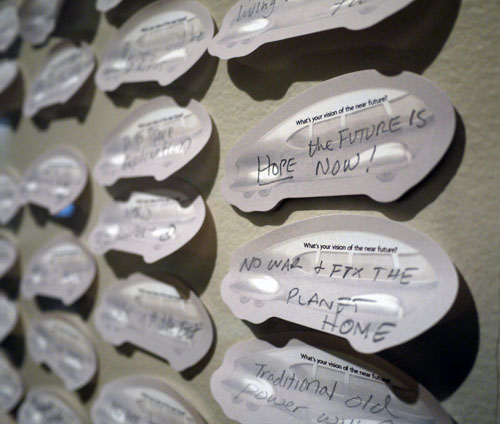
Image Credit: Laura Thain
In the pessimistic/apocalyptic responses, viewers reveal problems the claim exist in the present which can only become more dramatic in the future: “robots will complete their domination,” “civil war,” “our plan[e]t will be really polluted,” “more wildlife species go extinct,” “war in the Middle East,” “zombie apocalypse,” and “less pie.” Although some of the responses take their apocalyptic claims less seriously than others, all use the “future archive” to levy complaints against past and present.
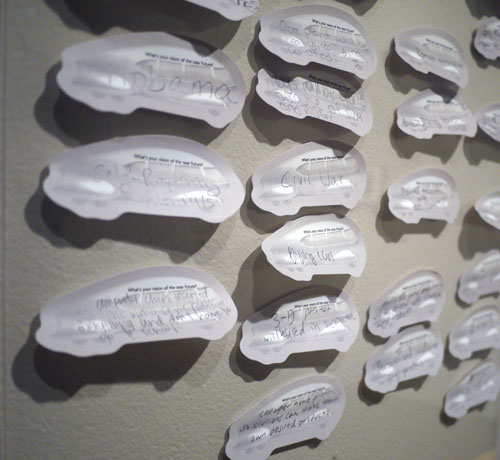
Image Credit: Laura Thain
Finally, there are those that, like Bel Geddes, make technological predictions that contain no value judgments. Technology is synonymous with progress in these sorts of claims, but all base their notions of future developments on the present “frontier:” “flying cars,” “materials and engineering will be based on [natural phenomena],” “everything [will be a] touch screen,” “personalized medicine using genetics,” “cheaper printers so civilians can make their own products,” “self-repairing materials,” or “deep space exploration.” These comments define what, among the current cutting edge technologies, constitutes “the frontier” and make inferences based on these assumptions, a style of futuristic archive that resembles Bel Geddean futurism more strongly than the optimistic or pessimistic visions of the future.
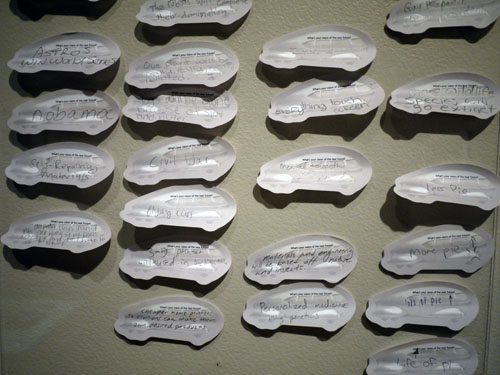
Image Credit: Laura Thain
I’d like to suggest that this neutral ethos is strongly related to the ethos of the Ransom Center’s archival practices in general and the role of critical distance in the process of archival acquisitions in particular. Although the Center has invested considerable resources in acquiring sources of importace to traditional notions of the Western Canon, its pre-20th century sources often do not compare to those of older, more heavily endowed archives. Instead, what distinguishes the Center’s archive is its eagerness to extend archival resources to 20th century materials and its attempt, most notably under Tom Staley, to acquire on the literary “frontier.” By making smart bets, or, we might say, futuristic prophesies about the future value of present literature, the Harry Ransom Center’s archival ethos shares much of the futuristic vision that its Bel Geddes exhibition celebrates.
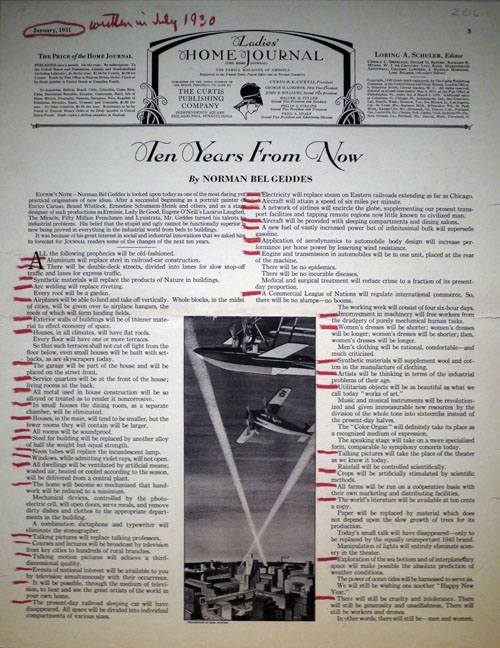
Image Credit: Laura Thain. Click for larger image.
One final note on “archives of the future”: the rapid technological innovation the exhibition’s audiences foresee (and not without good reason) also implies that as the rate of such innovation increases, so too does the process of archaicizing older technology. But while this translates to uselessness of futility in the world of technology, archaic or the past-oriented attributes in the literary world are a precondition of canonical status. As this canonical process becomes increasingly compressed, I’d venture to predict (perhaps optimistically?) that the canon of the future will expand even further.
The opinions expressed herein are solely those of viz. blog, and are not the product of the Harry Ransom Center.






Recent comments
2 years 29 weeks ago
2 years 44 weeks ago
2 years 44 weeks ago
2 years 50 weeks ago
3 years 4 weeks ago
3 years 4 weeks ago
3 years 4 weeks ago
3 years 6 weeks ago
3 years 6 weeks ago
3 years 6 weeks ago